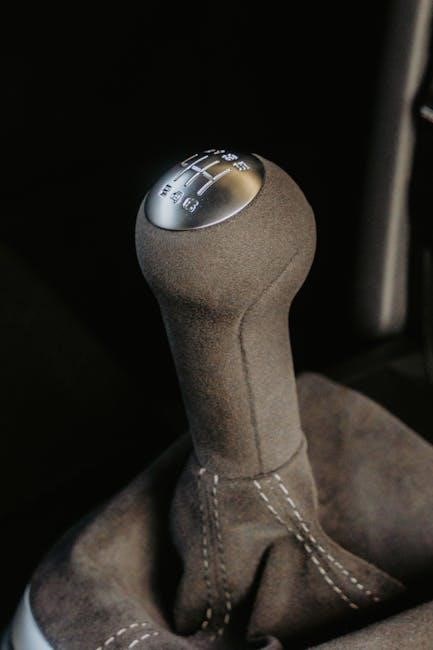
auto starter for manual transmission
Remote starters for manual transmissions offer convenience but pose safety risks. Proper installation, neutral gear, and precautions are essential to prevent accidents and ensure functionality.
Overview of Remote Start Technology
Remote start technology allows drivers to start their vehicles remotely, offering convenience and comfort. For manual transmissions, it requires specific safety protocols, such as neutral gear detection and parking brake engagement, to prevent accidental movement. Modern systems integrate with vehicle sensors to ensure safe operation, while aftermarket solutions like Compustar and Viper provide advanced features. Professional installation is crucial to avoid risks, with many installers requiring waivers due to liability concerns. This technology balances convenience with safety, making it a viable option for manual transmission owners who follow proper procedures.
Importance of Safety in Manual Transmission Remote Start Systems
Safety is paramount in manual transmission remote start systems to prevent unintended vehicle movement. Features like neutral gear detection and emergency brake engagement ensure the car doesn’t move during startup. Bypassing the clutch safety switch can lead to accidents, making it a critical component. Proper installation and adherence to safety protocols are essential to mitigate risks and protect both the vehicle and its surroundings from potential harm.

How Auto Starters Work with Manual Transmissions
Auto starters for manual transmissions require the vehicle to be in neutral with the parking brake engaged. The system ensures safety by preventing startup in gear, reducing accident risks.
Basic Principles of Remote Start Systems
Remote start systems for manual transmissions rely on specific safety protocols. The vehicle must be in neutral gear with the parking brake engaged to enable remote starting. Modern systems communicate with the engine control module to ensure safe ignition. Additional features like reservation mode require pre-set conditions, such as neutral gear detection, to activate. These principles minimize risks of accidental movement, ensuring the vehicle starts safely and remains stationary until the driver is ready to operate it.
Role of Neutral Gear and Parking Brake in Remote Start
The neutral gear and parking brake are critical for safe remote starting in manual transmissions. Placing the vehicle in neutral prevents unintended movement, while engaging the parking brake adds an extra layer of security. These steps ensure the car remains stationary when the engine starts remotely. Modern systems often require these conditions to activate, minimizing the risk of accidents and ensuring the vehicle starts safely without rolling or moving unexpectedly.
Clutch Safety Switch and Its Bypassing
The clutch safety switch prevents engine starting unless the clutch is pressed, ensuring safety in manual transmissions. Bypassing this switch is often required for remote start installation but poses risks. If the car is not in neutral, the vehicle could move unexpectedly. Modern systems may integrate safeguards, but bypassing the switch can override these protections, increasing accident potential. Professionals often avoid this due to liability concerns, emphasizing the importance of proper installation and safety protocols to mitigate risks associated with bypassing this critical feature.
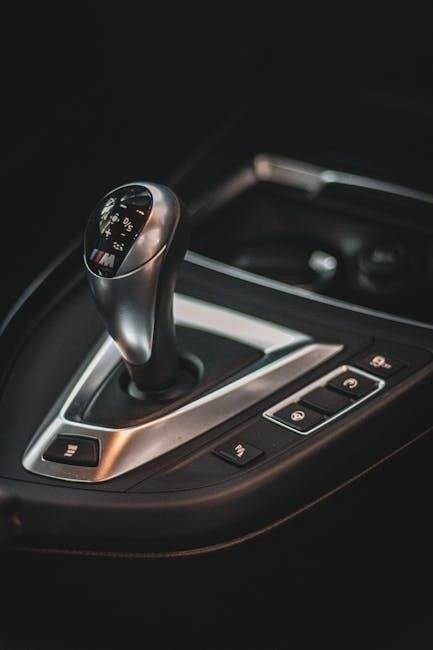
Safety Concerns and Risks
Remote starters for manual transmissions pose risks like accidental vehicle movement if not in neutral, emphasizing the need for strict safety protocols and legal compliance.
Liability Issues with Manual Transmission Remote Start
Installing a remote start on a manual transmission vehicle raises significant liability concerns. If the car is not in neutral, it may move unexpectedly, causing accidents. Many professionals refuse installations due to these risks, and manufacturers often avoid offering the feature. Users may be required to sign waivers, and improper installation can lead to legal consequences. The potential for harm makes liability a critical consideration for manual transmission remote start systems.
Risk of Accidental Vehicle Movement
Accidental vehicle movement is a primary concern with manual transmission remote starts. If the car isn’t properly secured in neutral or the parking brake fails, it can roll or lurch forward. This risk increases if safety features like the clutch switch are bypassed. Such incidents can result in property damage or injuries, emphasizing the need for strict safety protocols and proper installation to mitigate these dangers effectively.
Consequences of Bypassing Safety Features
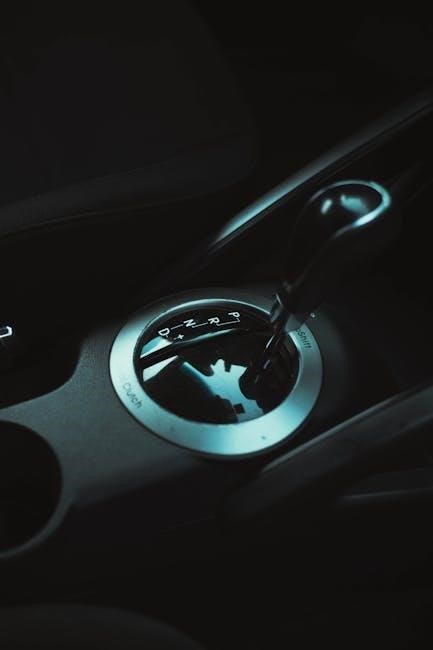
Bypassing safety features in manual transmission remote starts can lead to severe consequences. Disabling the clutch safety switch or ignoring neutral gear detection increases the risk of unintended vehicle movement. This can result in accidents, injuries, or property damage. Legal liability may also fall on the vehicle owner, as manufacturers and installers often void warranties or require waivers when such modifications are made. These risks highlight the importance of adhering to safety protocols to ensure secure operation.
Installation Considerations
Installing remote starters in manual transmissions requires professional expertise due to complex safety protocols. Specific requirements, like neutral gear detection and parking brake engagement, must be met to ensure safe operation and avoid legal issues.
Professional Installation Recommendations
Professional installation is crucial for manual transmission remote starters due to complex safety protocols. Installers must ensure the system integrates with the vehicle’s clutch safety switch and neutral gear detection. Specialized tools and expertise are required to bypass safety features without compromising vehicle security. Many professionals refuse installation due to liability risks, emphasizing the need for experienced technicians. Proper setup ensures the vehicle starts only in neutral with the parking brake engaged, minimizing accidental movement risks. Always follow manufacturer guidelines and consider signing liability waivers.
Special Requirements for Manual Transmissions
Manual transmissions require specific adjustments for remote starters, such as neutral gear detection and parking brake engagement. These systems must ensure the vehicle doesn’t start in gear to prevent unintended movement. Additional safety features like reservation mode and clutch bypassing are often necessary. Proper sequencing, such as exiting the vehicle and releasing the brake, is essential. These requirements ensure safe operation and prevent accidents, making manual transmission remote starters more complex than their automatic counterparts.
Waivers and Legal Implications
Installing a remote starter on a manual transmission often requires owners to sign liability waivers. Manufacturers and installers may not cover damages if the vehicle moves unintentionally. Legal implications arise if accidents occur due to improper installation or usage. Insurance policies might not cover such incidents, placing full responsibility on the vehicle owner. These legal considerations highlight the risks associated with aftermarket remote start systems on manual transmissions.
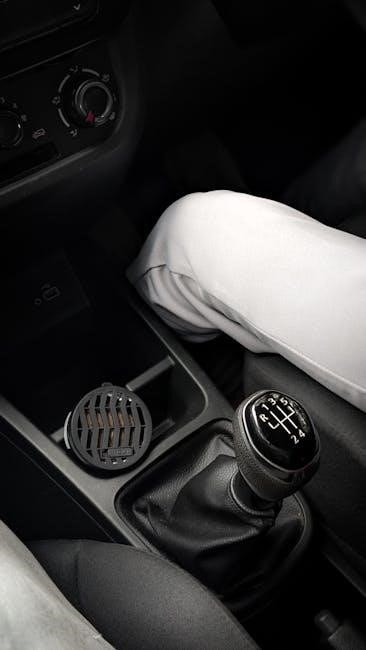
Key Features of Manual Transmission Remote Start Systems
Manual transmission remote start systems include neutral gear detection, emergency brake engagement, and reservation mode. These features ensure safe operation by preventing accidental vehicle movement.
Neutral Gear Detection
Neutral gear detection is a critical feature in manual transmission remote start systems. It ensures the vehicle is in neutral before starting, preventing unintended movement. Modern systems integrate sensors to verify gear position, enhancing safety. This technology is essential for safe remote starting, as it avoids the risk of the car lurching forward if started in gear. Proper installation and calibration are vital to ensure accurate detection and reliable operation.
Emergency Brake Engagement
Emergency brake engagement is a vital safety feature in manual transmission remote start systems. It ensures the vehicle remains stationary during remote starting by automatically activating the parking brake. This prevents accidental movement, especially on inclines. Modern systems integrate sensors to detect brake status, enhancing reliability. Proper installation and user adherence to safety protocols are crucial to ensure the emergency brake engages correctly, minimizing risks associated with remote starting manual transmission vehicles.
Reservation Mode for Safe Operation
Reservation Mode is a critical safety feature in manual transmission remote start systems. It requires the vehicle to be in neutral gear with the parking brake engaged before remote starting. This mode ensures the car cannot move unexpectedly, adding an extra layer of safety. Users must follow a specific sequence to activate Reservation Mode, which includes disengaging the clutch and securing the vehicle. This feature is essential for preventing accidental vehicle movement and ensuring safe operation of manual transmission remote start systems.
Popular Remote Start Systems for Manual Transmissions
Compustar, EasyGuard, and Viper are top choices for manual transmissions, offering advanced safety features and compatibility with unique requirements of manual vehicles.
Compustar CMX-Series Control Modules
Compustar’s CMX-Series stands out as a premier choice for manual transmissions, integrating advanced safety features like neutral gear detection and reservation mode. These modules ensure the vehicle is in neutral before starting, preventing accidental movement. Their reliability and compatibility with various manual vehicles make them a top recommendation among installers and enthusiasts. The CMX-Series is designed to mitigate risks associated with remote starting, offering a secure and user-friendly experience.
EasyGuard Remote Engine Start System
The EasyGuard Remote Engine Start System is a user-friendly solution for manual transmissions, offering a compact design and straightforward operation. It ensures safe remote starting by requiring the vehicle to be in neutral and the emergency brake engaged. This system provides added security with its alarm features, making it a reliable choice for manual transmission owners seeking convenience without compromising safety. Its simplicity and effectiveness make it a popular option among drivers who value ease of use and peace of mind.
Viper Remote Start Alarm System
The Viper Remote Start Alarm System is a reliable option for manual transmissions, combining remote start functionality with advanced security features. It ensures safe operation by requiring the vehicle to be in neutral and the parking brake engaged before starting. Viper’s system offers long-range control and additional safety nets, such as reservation mode, to prevent accidental movement. Its integration of alarm features provides enhanced protection, making it a top choice for drivers seeking both convenience and security in their manual transmission vehicles.

Step-by-Step Usage Guide
Ensure the vehicle is in neutral, engage the parking brake, and follow the remote start sequence to safely activate and shut down the engine remotely.
Starting the Vehicle Remotely
To start your manual transmission vehicle remotely, ensure it is in neutral gear and the parking brake is engaged. Press the remote start button on your fob, typically two to three times, to activate the system. The engine will start, but the vehicle will not move due to safety features like neutral gear detection. Once started, the vehicle remains in accessory mode until you are ready to drive. Always follow the manufacturer’s instructions for safe operation.
Shutting Down the Vehicle Safely
To shut down the vehicle safely, press the remote start button again to deactivate the system. Ensure the vehicle is in a stationary position and the parking brake is engaged. Return to the vehicle, disarm the system, and insert the key into the ignition. Turn the key to the “off” position to complete the shutdown. Always verify the vehicle is secure and the engine is off before leaving it unattended. This ensures safe operation and prevents potential accidents.
Arming and Disarming the System
Arming the system requires placing the vehicle in neutral gear and engaging the parking brake. Press the remote fob button to activate the system, ensuring the vehicle is secure. Disarming involves re-entering the vehicle, inserting the key, and turning the ignition. The remote start system will deactivate automatically. Always follow the manufacturer’s sequence to avoid accidental starts or movement. Proper arming and disarming ensure safe operation and prevent potential risks associated with manual transmission remote starters.

Pros and Cons of Remote Start for Manual Transmissions
Remote starters offer convenience for manual transmissions, allowing pre-starting, but pose risks like accidental movement if not in neutral. Safety features are crucial to mitigate these hazards.
Convenience and Comfort
Remote starters for manual transmissions provide unmatched convenience, allowing drivers to pre-start their vehicles and warm up the engine. This feature is especially beneficial in cold climates, ensuring a comfortable cabin and defrosted windows. However, users must follow specific procedures, such as shifting into neutral and engaging the parking brake, to safely activate the system. While these steps add a few seconds to the process, they enhance overall comfort and ease of use, making remote starters a valuable upgrade for manual transmission owners.
Increased Risk of Accidents
Remote starters for manual transmissions can increase accident risks if not installed or used correctly. Vehicles may roll or lurch forward if the parking brake isn’t securely engaged or if the transmission isn’t in neutral. Bypassing safety features like the clutch switch heightens these dangers, potentially leading to unintended movement. Accidents can result in property damage or personal injury, making proper installation and adherence to safety protocols crucial to mitigate these risks and ensure safe operation.
Cost and Maintenance
Installing a remote start system for a manual transmission can range from $500 to $1,500, depending on features and complexity. Advanced systems with neutral detection or bypass modules may increase costs. Professional installation is highly recommended, adding labor fees. Maintenance involves regular checks of sensors and wiring to ensure reliability. While the convenience is appealing, the upfront cost and ongoing upkeep can be significant, making some users question the practicality of such systems for manual vehicles.
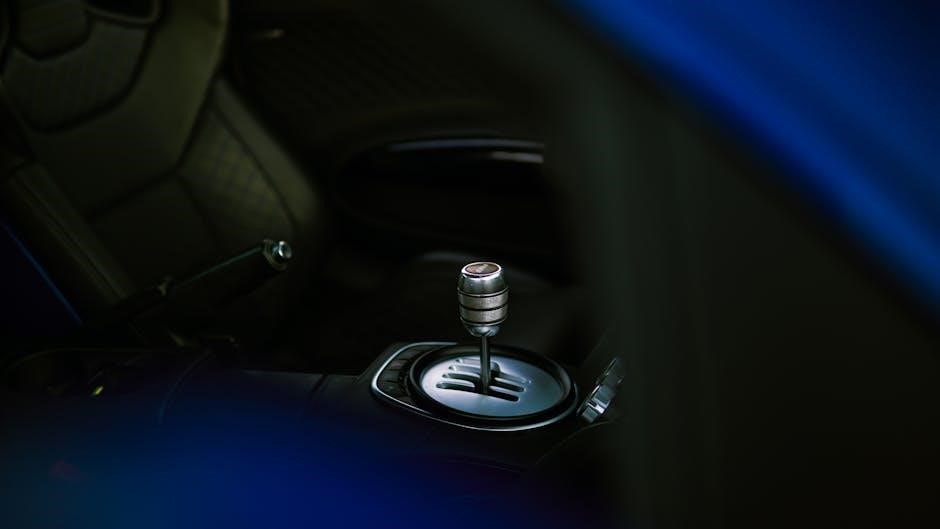
Legal and Liability Considerations
Manufacturers often avoid liability by not supporting remote starts for manual transmissions. Installers may require waivers, and owners face legal risks if accidents occur due to improper use.
Manufacturer Policies on Manual Transmissions
Most manufacturers, like Honda, do not support remote start systems for manual transmissions due to safety and liability concerns. Many dealers refuse to install such systems, citing potential risks. Some manufacturers explicitly warn against aftermarket installations, emphasizing the importance of safety features like neutral gear detection. Owners may face voided warranties or legal issues if accidents occur. As a result, manufacturers often advise against remote starts for manual transmissions to avoid liability and ensure driver safety.
Insurance Implications
Installing a remote start on a manual transmission may affect insurance coverage. Many insurers view it as a high-risk modification, potentially increasing premiums or voiding policies. Accidents caused by improper installation or misuse could lead to denied claims. Owners must disclose such modifications to their insurers, as failure to do so may result in coverage denial. Additionally, liability risks associated with accidental vehicle movement may not be fully covered, leaving owners financially vulnerable in case of incidents.
Owner Responsibility
Owners of manual transmission vehicles with remote start systems bear significant responsibility. They must ensure proper installation, follow safety protocols, and regularly maintain the system. Misuse, such as failing to engage the parking brake or neglecting neutral gear, can lead to accidents. Owners are also accountable for understanding and adhering to all legal and manufacturer guidelines. Proper training and awareness are crucial to mitigate risks and ensure safe operation of the remote start feature in their vehicles.

Remote starters for manual transmissions offer convenience but require caution. Safety measures and responsible usage are crucial to avoid accidents and ensure proper functionality of the system.
Final Thoughts on Manual Transmission Remote Start
Remote starters for manual transmissions offer convenience but require extreme caution. While systems like Compustar provide safety features, risks remain if not installed or used properly. Liability concerns and potential accidents make many professionals hesitant. Proper installation, neutral gear detection, and emergency brake engagement are critical. Users must weigh the benefits against risks and ensure all safety protocols are followed to avoid unintended vehicle movement; Responsible usage and adherence to manufacturer guidelines are essential for safe operation.
Recommendations for Potential Users
For those considering a remote start for a manual transmission, prioritize safety and liability awareness. Choose reputable brands like Compustar, known for robust safety features. Ensure proper installation by professionals, as DIY setups can pose risks. Always follow manufacturer guidelines and consider vehicle-specific requirements. Weigh the convenience against potential risks, especially accidental movement. Users must commit to strict usage protocols, including neutral gear and parking brake engagement, to mitigate hazards. Responsible installation and operation are paramount for a safe experience.